It looks like you're using an Ad Blocker.
Please white-list or disable AboveTopSecret.com in your ad-blocking tool.
Thank you.
Some features of ATS will be disabled while you continue to use an ad-blocker.
share:
Is your sir name Moore, Moor,Morrison,Black,Blackman, Blackson,Brown,Sacracen, you might be a decendant of Christianized Moors, not all Black figures
that showed up on European coat of Arms are founders of such families,some have that images on the coat of arms because they were fighting the Moors
rather than making babies with them,others were an allusion to the divine others were paying homage to St. Maurice the first Knight.But when the Sir
names are of the above and connected to the black imagery then that family's founder may well have been a Moor.
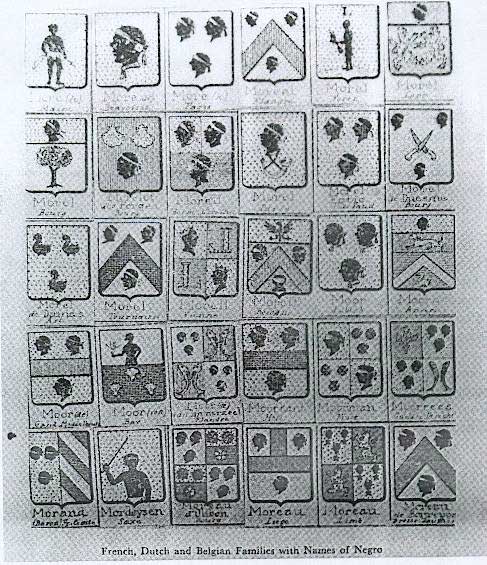
Some of this is faint but you can still read the Sir names of the families attached to them..remember these are coat of arms of founders of families they were the ones who commissioned these crest.
The surnames w/locale include (top to bottom and left to right)
More de Maine, More de Beavoisis, More de Paris, More el Flandre, Morel Forez, Morel Lorr Morel Bourg, Morelet des Forges Bourg, Morell Berne Land(...), Morel Paris, Morel Fatio Pide Vaud, Morel de Duesme Bourg Morel de Damas Art, Morel Tourais(..), Morell Vienne, Morelli Bologne, Moor Lubeck, Moor Anvers Moor de Gand Middelbour, Moor de van Imerzeel Flandre, Moorkant Holl, Moorman Frise, Moorrees Gueldre Utrecht Moorand Baron (..)lointe, Mordeysen Saxe, Moreau d'Oliban Bourg, Moreau Liege, Moreau Limb, Moreau de Bo(..)epos Bresse Dauphin
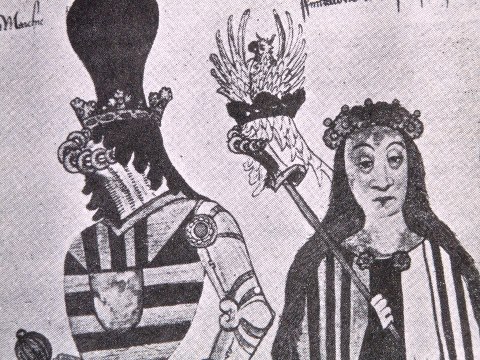
David MacRitchie published this image of a "Norman knight" and his fair lady:
Cover illustration: A Black Norman knight, with his lady. From the Heraldic Collection of Sir Thomas Wriothesley, Garter King-of-Arms, 1504-1534
Ancient and Modern Britons Vols I & II, by David MacRitchie first published in London in 1884
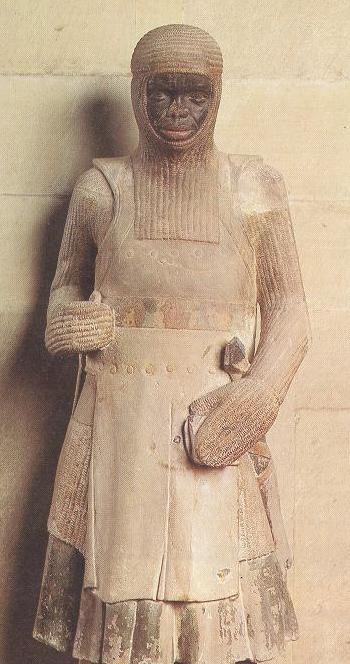
Sir Morien King Arthur's Knights of the Round Table
The romance begins with the story of Morien's conception. While searching for Lancelot thirteen years prior, Aglovale had traveled through the Moorish lands and fallen in love with a beautiful princess. They pledged their betrothal, but refusing to abandon his quest before Lancelot was located, Aglovale left the country before they could marry. He left her pregnant with his son Morien, who would grow into a tall, handsome youth "black of face and limb."[3] Of his prowess, the romance says that Sir Morien's "blows were so mighty; did a spear fly towards him, to harm him, it troubled him no whit, but he smote it in twain as if it were a reed; naught might endure before him." Of his dress, it says that "[h]is shield and his armour were even those of a Moor, and black as a raven.
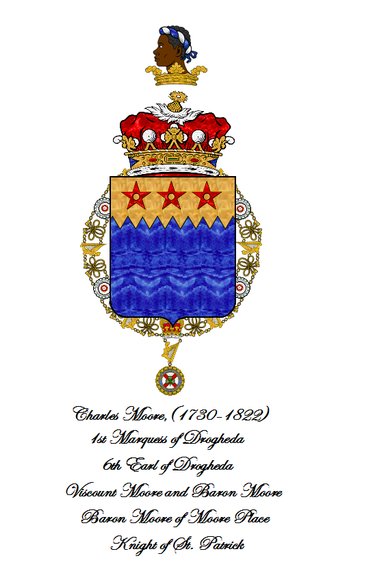
THE MARQUESSES OF DROGHEDA WERE THE PENULTIMATE LANDOWNERS IN COUNTY KILDARE WITH 16,609 ACRES
From two brothers, SIR EDWARD and SIR THOMAS MOORE, knights (descendants of the Moores of Moore Place, Kent), who went over to Ireland, in the reign of ELIZABETH I, sprang the house of Drogheda and the extinct house of Charleville and Tullamore.
SIR EDWARD MOORE, the elder brother, obtained, for his services, from the Queen, a lease of the dissolved abbey of Mellefont, with its appurtenances, County Louth, which he made the principal place of his abode; and so it continued that of his descendants until their removal to Moore Abbey, County Kildare, the seat of the Viscounts Loftus of Ely, which devolved upon the Earl of Drogheda.
Sir Edward's surviving son Garret was created 1st Viscount Moore.
The 1st and 3rd Marquesses of Drogheda were Knights of St Patrick (KP). The 11th Earl was a Knight of the Garter. It is notable that the crest of the Moore family is a Moor's head.
lordbelmontinnorthernireland.blogspot.jp...
And you can look at the book of Heraldry and find the families to match.
archive.org.../396/mode/2up
This presentation by Dr. Jose Pimienta-Bey is a fantastic account of who the Moors were, how they gained power in the Iberian Pennisula today know as Spain and Portugal and even more importantly, how they lost power. Many of us dont know that African (Moors) along with Arabs, ruled Spain from 711 A.D. 1492 A.D. They made considerable contributions to Europe who was going through the Dark Ages.
The Moors contributed to science, medicine, Art, Mathematics, Agriculture, etc.

Some of this is faint but you can still read the Sir names of the families attached to them..remember these are coat of arms of founders of families they were the ones who commissioned these crest.
The surnames w/locale include (top to bottom and left to right)
More de Maine, More de Beavoisis, More de Paris, More el Flandre, Morel Forez, Morel Lorr Morel Bourg, Morelet des Forges Bourg, Morell Berne Land(...), Morel Paris, Morel Fatio Pide Vaud, Morel de Duesme Bourg Morel de Damas Art, Morel Tourais(..), Morell Vienne, Morelli Bologne, Moor Lubeck, Moor Anvers Moor de Gand Middelbour, Moor de van Imerzeel Flandre, Moorkant Holl, Moorman Frise, Moorrees Gueldre Utrecht Moorand Baron (..)lointe, Mordeysen Saxe, Moreau d'Oliban Bourg, Moreau Liege, Moreau Limb, Moreau de Bo(..)epos Bresse Dauphin

David MacRitchie published this image of a "Norman knight" and his fair lady:
Cover illustration: A Black Norman knight, with his lady. From the Heraldic Collection of Sir Thomas Wriothesley, Garter King-of-Arms, 1504-1534
Ancient and Modern Britons Vols I & II, by David MacRitchie first published in London in 1884

Sir Morien King Arthur's Knights of the Round Table
The romance begins with the story of Morien's conception. While searching for Lancelot thirteen years prior, Aglovale had traveled through the Moorish lands and fallen in love with a beautiful princess. They pledged their betrothal, but refusing to abandon his quest before Lancelot was located, Aglovale left the country before they could marry. He left her pregnant with his son Morien, who would grow into a tall, handsome youth "black of face and limb."[3] Of his prowess, the romance says that Sir Morien's "blows were so mighty; did a spear fly towards him, to harm him, it troubled him no whit, but he smote it in twain as if it were a reed; naught might endure before him." Of his dress, it says that "[h]is shield and his armour were even those of a Moor, and black as a raven.

THE MARQUESSES OF DROGHEDA WERE THE PENULTIMATE LANDOWNERS IN COUNTY KILDARE WITH 16,609 ACRES
From two brothers, SIR EDWARD and SIR THOMAS MOORE, knights (descendants of the Moores of Moore Place, Kent), who went over to Ireland, in the reign of ELIZABETH I, sprang the house of Drogheda and the extinct house of Charleville and Tullamore.
SIR EDWARD MOORE, the elder brother, obtained, for his services, from the Queen, a lease of the dissolved abbey of Mellefont, with its appurtenances, County Louth, which he made the principal place of his abode; and so it continued that of his descendants until their removal to Moore Abbey, County Kildare, the seat of the Viscounts Loftus of Ely, which devolved upon the Earl of Drogheda.
Sir Edward's surviving son Garret was created 1st Viscount Moore.
The 1st and 3rd Marquesses of Drogheda were Knights of St Patrick (KP). The 11th Earl was a Knight of the Garter. It is notable that the crest of the Moore family is a Moor's head.
lordbelmontinnorthernireland.blogspot.jp...
And you can look at the book of Heraldry and find the families to match.
archive.org.../396/mode/2up
This presentation by Dr. Jose Pimienta-Bey is a fantastic account of who the Moors were, how they gained power in the Iberian Pennisula today know as Spain and Portugal and even more importantly, how they lost power. Many of us dont know that African (Moors) along with Arabs, ruled Spain from 711 A.D. 1492 A.D. They made considerable contributions to Europe who was going through the Dark Ages.
The Moors contributed to science, medicine, Art, Mathematics, Agriculture, etc.
Moors weren't black by the way, they were of south european/mediterranean appearance
It's funny how the Euro-centric western history never tells you how much Africans contributed to European culture (maths, medicine, education, art,
etc.). The Moors helped Europe get out of the "dark ages'. While Africa was thriving, Europe was declining. The Moors helped Europeans get out of
that mess.

ixwa.hubpages.com...

It must be recalled that the Iberian peninsula was made great by the labors of the Moors. They established the silk industry; they were highly skilled agriculturists; introducing cotton, rice, sugar cane, dates, lemons, and strawberries into the contry. Abu Zaceria and Ibn Alaman wrote authoritative remarks on Moorish animal husbandry and agriculture. Ibn Khaldun, a Moorish agriculturist, wrote a treatise on farming and worked out a theory of prices and the nature of capital. (He was called the Karl Marx of the Middle Ages.) Caliph er Rahan of Cordova ordered the construction of an aqueduct, which conveyed pure water from the mountains to the city. Extensive irrigation systems were constructed by Moorish engineers, who also built large underground silos for storing grain. The mineral wealth of the land was utilized to the fullest. Copper, gold, silver, tin, lead, iron, quicksilver, and alum were extensively mined. Cordova and Morocco had the best tanneries in the world. The city of Toledo had the finest sword blades in the European continent . Almeria specialized in the making of sashes, which were famous for their fine texture and brilliant color. The world renowned carpets were form Teulala, and bright-hued woolens in Granada and Baza. High quality glass, pottery, vases,mosaics and jewelry were produced by Moorish artisans.
The most wonderful city in the world of the age was Cordova (Spain), the streets were well-paved, with raised sidewalks for pedestrians. During the night, ten miles of strees were well illuminated by lamps. (This was hundreds of years before there was a paved street in Paris or a street lamp in London.) Cordova had a population of at least one million, and it being served by four thousand public markets and five thousand mills. Public baths numbered in the hundreds. The amenity was present at a time when cleanliness in Christian Europe was regarded as a sin. Education was universal in Moorish Spain, available to the most humble, while in Christian Europe ninety-nine percent of the population were illiterate, and even kings could neither read nor write. The Moorish rulers lived in sumptuous palaces, while the monarchs of Germany, France, and England dwelt in big barns, with no windows and no chimneys, and with only a hole in the roof for the exit of smoke.
In the tenth and eleventh centuries, public libraries in Europe were nonexistent, while Moorish Spain could boast of more than seventy, of which the one in Cordova housed six hundred thousand manuscripts. Christian Europe contained only two universities, while in the Moorish Spain there were seventeen great universities. The finest of these were located in Almeria, Cordova, Granada, Juen, Malaga, Seville and Toledo. Scientific progress in astronomy, chemistry, physics, mathematics, geography and philosophy flourished in Moorish Spain Scholars, scientists and artists formed learned societies, and scientific congresses were organized to promote research and to facilitate the spread of knowledge. A brisk intellectual life flourished in all Islamic dominions, since both caliphs of East and West were as a rule, enlightened patrons of learning. A vivid reconstruction of the splendors of Moorish Spain, as seen by Abd-er-Rhaman III,Caliph of Cordova and his companions, ahs been preserved for us by a recognized authority on the history of the period, Josseph McCabe as follows:
ixwa.hubpages.com...
Originally posted by Credenceskynyrd
Moors weren't black by the way, they were of south european/mediterranean appearance
Most were black. Some were arab. Why are you ignoring the paintings in the OP that clearly show black men? Here are some more for you to ignore.

edit on 17-2-2013 by WaterBottle because: (no reason given)
reply to post by WaterBottle
There are those who would have you believe that Africans have always run around in a loin cloth, holding a spear, and just aren't quite as smart as the rest of us. So surely they could not have contributed anything to civilization of note.
It's funny how the Euro-centric western history never tells you how much Africans contributed to European culture (maths, medicine, education, art, etc.).
There are those who would have you believe that Africans have always run around in a loin cloth, holding a spear, and just aren't quite as smart as the rest of us. So surely they could not have contributed anything to civilization of note.
Originally posted by Credenceskynyrd
Moors weren't black by the way, they were of south european/mediterranean appearance
It's not as simple as Black and White for while all Blacks were Moors all Moors weren't actually Black given that they mixed with Europeans which is kind of the point of this thread,for one thing Moor meant Black in all European languages,if they wanted to describe someone among them that is not so dark they simply called them twanny Moors,or if there were Whites who lived with the Moors adopted their religion and customs then they called those white Moors,the equivalent of calling some white youths today wiggers if they are deep into hiphop culture.. Mod ( if that word is an offense I'll remove it) but going back even before the Islamic conquest we have this from the Romans talking about Moors like the below
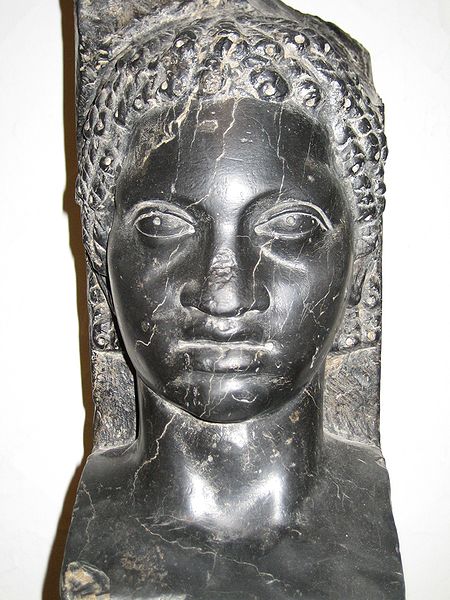
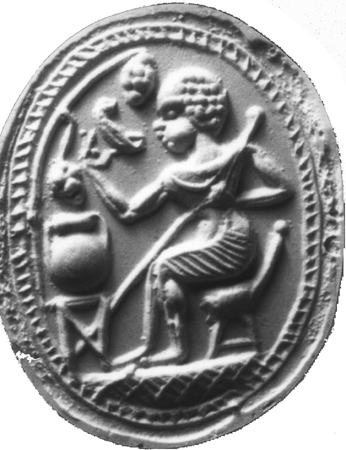

Carthaginians in Ibiza Spain.
“Grieve not at this, poor wretch, and with thine own hand give thy wife the potion whatever is be for did she choose to bear her leaping children in her womb thou wouldst, perchance, become the sire of an Ethiop, a blackamoor would soon be your sole heir.”
- Juvenal, Satire VI, lines 596 – 600
“One of them, with wooly hair, like a Moor, seems to be the son of Santra, the cook. The second, with a flat nose and thick lips, is the image of Pannicus, the wrestler . . . of the two daughters, one is black . . . and belongs to Crotus, the flute player.”
- Martial, VI, 39.
“When tired of each noblest matron, (Gildo) hands her over to the Moors. These Sidonian mothers, married in Carthage City, must needs be mate with barbarians. He thrusts upon me an Ethiopian son-in-law. This hideous hybrid affects the cradle.”
Claudian.
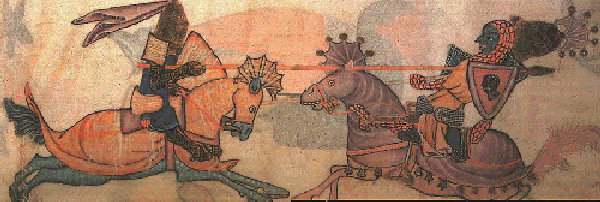
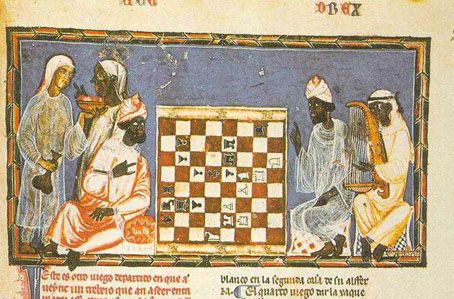
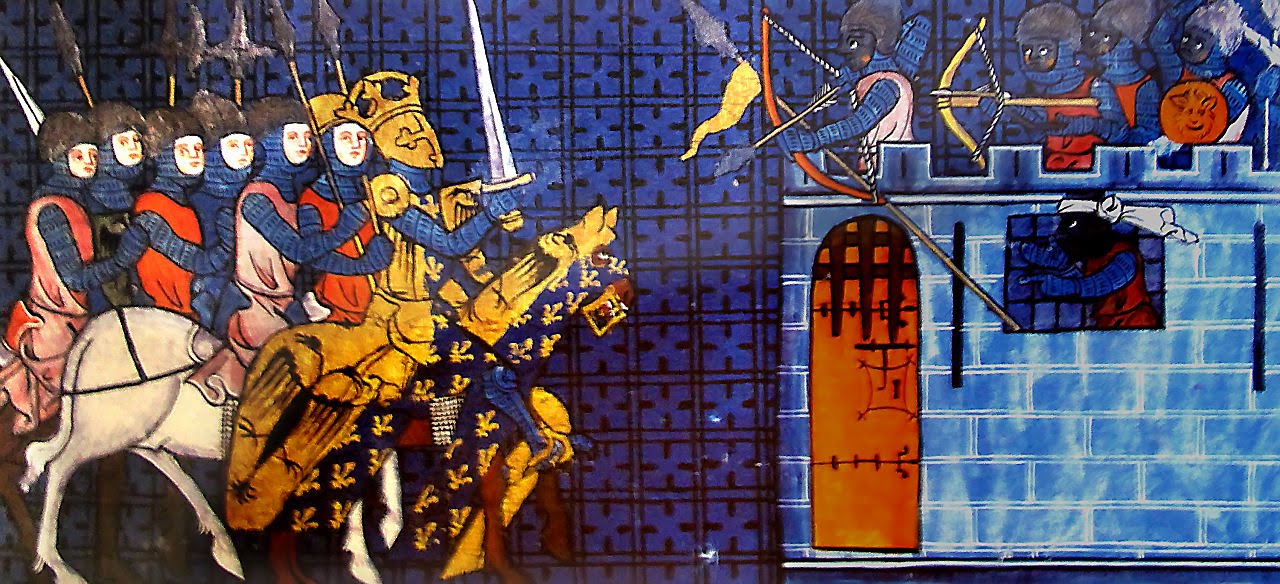
From the much later Islamic era we have these description.
In the ‘Chanson of Roland’ (Song of Roland) written after the Moors invaded France in 718 A.D., the invaders are described (verses 145 and 146) as “blacker than ink with large noses and ears” and with “nothing white except the teeth.” (Moriaen. Arthurian Romance No. 4, PP. 29, 39, 41, 103. 1907. Trans. by J. L. Watson). The Chanson of Roland states that the Moorish army was 50,000 strong and led by Marganice, Emperor of Ethiopia and Carthage. Their most valiant figure is Abisme (that is, Abyssinian), who (verse 126) is described as “black as melted pitch.” In this epic, the Moors are called Sarrazins, in English, Saracens.
Orkneyinga saga Moors vs Vikings Once both parties were on board there was fierce fighting,the people on the Dromond being Saracens,whom we called infdels of Mohammed, among them a good many black men,who put up a strong resistance. Earling,honored aimer of spears,eagerly advanced toward the vassel in victory,with banners of blood;the black worriors,brave lads we captured or killed,crimsoning our blades,busey with this Dromond business our blades we bloodied on the blacks. Read more: egyptsearchreloaded.proboards.com...
A note if want to read/research African connection/contribution to areas out side Africa please visit thread below leave a comment,correct or critize it's all good.
The Great Lakes And The Kongo Links To Nile Valley Civilizations
www.abovetopsecret.com...
Klik Me^
edit on 17-2-2013 by Spider879 because: (no reason given)
yeah, those pesky cavemen Europeans couldn't have managed all they achieved without all those significant efforts by black africans, wise up, and
stop trying to claim things which are not there
Iceland for example, it clawed itself out of a harsh environment to develop a civilisation with all those west africans eh
Stop overcooking minor points of European history ffs
Iceland for example, it clawed itself out of a harsh environment to develop a civilisation with all those west africans eh
Stop overcooking minor points of European history ffs
we can all be selective in pictures we choose
en.wikipedia.org...:Jaume_I,_Cantigas_de_Santa_Maria,_s.XIII.jpg
Like I say, afrocentric mania drives a lot of people in their comments about European history- sure the moors are part of a small element of European history but black africans are certainly not the primary reason for European advancements lol
en.wikipedia.org...:Jaume_I,_Cantigas_de_Santa_Maria,_s.XIII.jpg
Like I say, afrocentric mania drives a lot of people in their comments about European history- sure the moors are part of a small element of European history but black africans are certainly not the primary reason for European advancements lol
reply to post by Credenceskynyrd
Oh. Are you offended people are saying Africans helped Europeans out? You poor thing.
Stating facts makes you upset, how weird.
Oh. Are you offended people are saying Africans helped Europeans out? You poor thing.
Stating facts makes you upset, how weird.
edit on 17-2-2013 by WaterBottle because: (no reason given)
reply to post by WaterBottle
No he is stating that moors helped out, and are even "part of a small element of European history". So you seem to be the offended here.
He was just pointing out, that some people make it look like without the help of black people europen people would be still living in caves or something like that.
No he is stating that moors helped out, and are even "part of a small element of European history". So you seem to be the offended here.
He was just pointing out, that some people make it look like without the help of black people europen people would be still living in caves or something like that.
You understand that history was written in the 1800's? With an 1800's view of how anyone who lived prior to that epoch were stone age morons? Irving
Washington was one of the first who wrote a series of ridiculous biographies of the founding fathers, taking them from scum to heros, taking
Christopher Columbus, one of the vilest human beings who ever lived and turning him into a saint... The concept of the renaissance is based on a book
about the evolution of paintings in Italy with the arrival of Michaelangelo.
The whole concept of the dark ages is ridiculous. The fall of the Roman Empire created the worst economic crisis the world has known. These stories about dark ages are from the 1800's and never existed before. After hundreds of years living in the Roman Empire, do you truly believe that only Rome had schools and universities and technology???
No serious historian today believes in the myth of the dark ages. So to say that people from elsewhere helped the poor Europeans come back into civilisation is ridiculous.
As for the whole black vs white thing, that also has its origins in the 1800's, from US black slavery. Before that period, there never was the current kind of hatred between blacks and whites.
The Moors did play an important part in European history, although mostly in Spanish history. Whether they were black or white doesn't change anything, nor did it change anything at the time.
The whole concept of the dark ages is ridiculous. The fall of the Roman Empire created the worst economic crisis the world has known. These stories about dark ages are from the 1800's and never existed before. After hundreds of years living in the Roman Empire, do you truly believe that only Rome had schools and universities and technology???
No serious historian today believes in the myth of the dark ages. So to say that people from elsewhere helped the poor Europeans come back into civilisation is ridiculous.
As for the whole black vs white thing, that also has its origins in the 1800's, from US black slavery. Before that period, there never was the current kind of hatred between blacks and whites.
The Moors did play an important part in European history, although mostly in Spanish history. Whether they were black or white doesn't change anything, nor did it change anything at the time.
Silly white people think they had anything important to contribute in the past.
All ancient sites for maybe some pile of rocks in the u.k were built by people of colour.
Human history contains very little positive white influence. Maybe whites will be the new need to be exterminated race for history dictates their arrival and influence as a plague.
For your information my lineage goes back to the Romans, Greeks, Arabs, Moors, and related to ancient Portuguese explorers.
Neanderthals helped Caucasians out of the caves.
All ancient sites for maybe some pile of rocks in the u.k were built by people of colour.
Human history contains very little positive white influence. Maybe whites will be the new need to be exterminated race for history dictates their arrival and influence as a plague.
For your information my lineage goes back to the Romans, Greeks, Arabs, Moors, and related to ancient Portuguese explorers.
Neanderthals helped Caucasians out of the caves.
edit on 17-2-2013 by Shadow Herder because: (no reason given)
Alot of folks here are missing the point,any large urban civilization by their very nature will become multi-ethnic and diverse,but all too often it
is the African who gets ignored while at the sametime his symbols and concepts are misappropriated,history should not be a pp contest but you can't
go bury things that make you feel discomfort,so far non has suggest that Europeans have no originality well...except for Shadow Herder and I think he
is being facetious,and Credenceskynyrd 700red yrs is a lot of face time with those Moors,one of the purpose of this thread is shake some folks out of
their narrow views take a second or third look at what you think you know.
You know its easy to tell the race of a person by their skull so where are all these Black peoples skeletons, why arnt our archeologists finding them
all over Europe...better still why are Europeans so white...did they refuse to mate with these moors? More importantly we have books going back that
long in Ireland and UK, there is no reference of this.
edit on 17-2-2013 by LUXUS because: (no reason given)
reply to post by ajmusicmedia
This is correct. The fall of the Roman empire, followed by a series of climate disasters and disease pandemics, were what kept Europe "in the dark". Africa continued to thrive, free of the majority of the cold that Europe was faced with.
This is correct. The fall of the Roman empire, followed by a series of climate disasters and disease pandemics, were what kept Europe "in the dark". Africa continued to thrive, free of the majority of the cold that Europe was faced with.
reply to post by Spider879
There is no doubt that Moors had an impact on the region they populated. No doubt that the impact didn't spread out a little in the areas surrounding their habitats. But the world at that time was not multiethnic. There were a few random travellers, etc. But you didn't have masses of folks moving from one part of the world to another. The "races" of humans became what they were because of isolation, not integration.
There is no doubt that Moors had an impact on the region they populated. No doubt that the impact didn't spread out a little in the areas surrounding their habitats. But the world at that time was not multiethnic. There were a few random travellers, etc. But you didn't have masses of folks moving from one part of the world to another. The "races" of humans became what they were because of isolation, not integration.
double post
edit on 17-2-2013 by bigfatfurrytexan because: (no reason given)
Originally posted by LUXUS
You know its easy to tell the race of a person by their skull so where are all these Black peoples skeletons, why arnt our archeologists finding them all over Europe...better still why are Europeans so white...did they refuse to mate with these moors? More importantly we have books going back that long in Ireland and UK, there is no reference of this.edit on 17-2-2013 by LUXUS because: (no reason given)
You are making assumptions here they leave their remains,genetic traces records have been found just that most folks don't go looking
NEARLY 2,000 years ago, York was the most important place in the western hemisphere. The Roman Emperor had taken up residence and thousands of social climbers from all corners of the empire flocked to the city to be part of the scene.
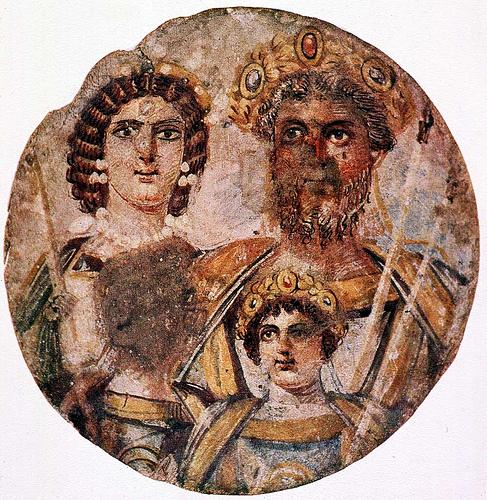
The man attracting all the fuss was Septimius Severus, the first black citizen to hold Rome’s highest office. For the final three years of his reign, he made York his home and brought to the city a cosmopolitan period of culture, fashion and importance that has not been matched since.
www.yorkpress.co.uk...
He was in a three way battle between Pescennius Niger another African and an Iberian Decimus Clodius Albinus he came out on top.
The last names of both Pescennius Niger and Decimus Clodius Albinus are interesting in that they suggest a connection to complexion as Niger is Latin for black hence the later formation of the term Negro or people of the Niger river in Africa,and Albinus suggest a very white skinned person.
Think of today's political scene in America where you have Herman Cain who was for a little while a true contender going up against Obama,with Newt Gingrich or Mit Romney playing Albinus.
Now when the confusion in the state was at its height, inasmuch as it was made known that there were three separate emperors, Septimius Severus, Pescennius Niger, and Clodius Albinus, the priest of the Delphic Apollo was asked which of them as emperor would prove of most profit to the state, whereupon, it is said, he gave voice to a Greek verse as follows:
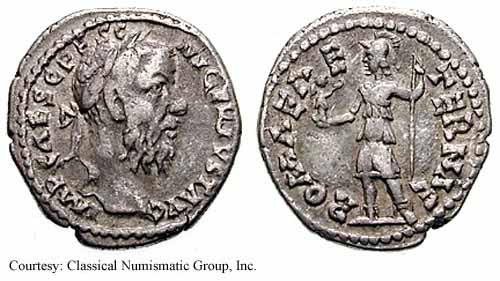
Pescennius Niger
"Best is the Dark One, the African good, but the worst is the White One."
p4492 And in this response it was clearly understood that Niger was meant by the Dark One, Severus by the African, and Albinus by the White One. 3 Thereupon the curiosity of the questioners was aroused, and they asked who would really win the empire. To this the priest replied with further verses somewhat as follows:
"Both of the Black and the White shall the life-blood be shed all untimely;
Empire over the world shall be held by the native of Carthage."
4 And then when the priest was asked who should succeed this man, he gave answer, it is said, with another Greek verse:
penelope.uchicago.edu...
Klik for the full verses.
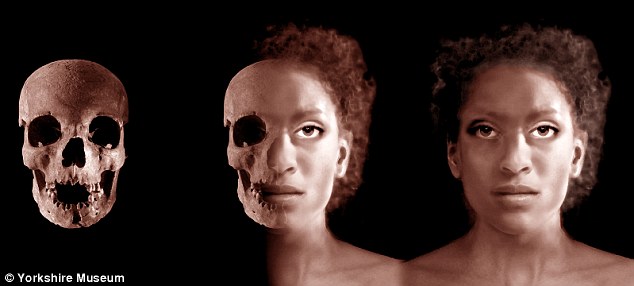
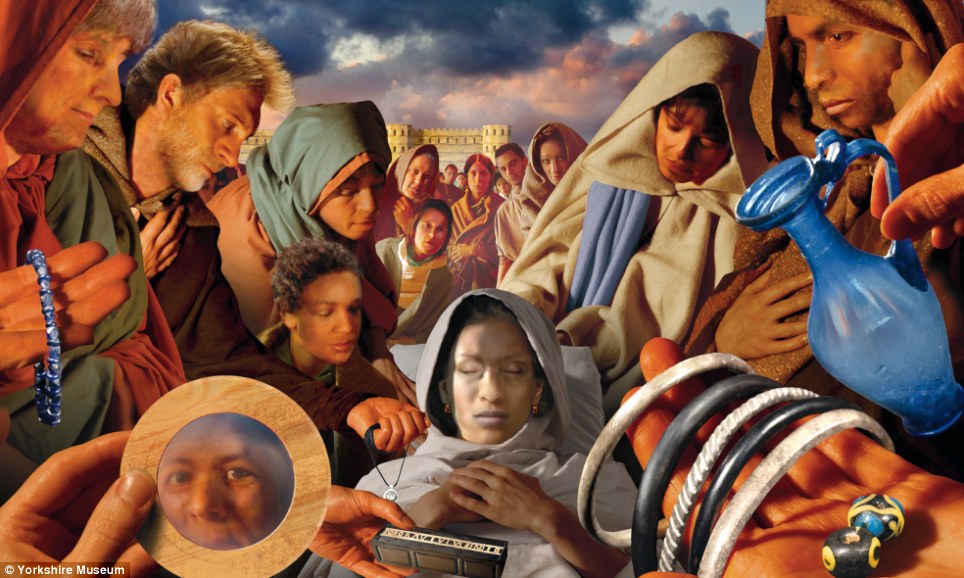
The Ivory Bangle Lady,
Academics say the discovery goes against the common assumption that all Africans in Roman Britain were low status male slaves.
Remains of the Ivory Bangle Lady, as she has been named, were studied in Reading using forensic techniques.
She was first discovered in the Bootham area of York in August 1901.
Her remains were in a stone coffin near Sycamore Terrace in the city.
Her grave dates back to the second half of the 4th Century. She was buried with items including jet and elephant ivory bracelets, earrings, beads and a blue glass jug.
She also had a rectangular piece of bone, which is thought to have originally been mounted in a wooden box, which was carved to read, "Hail, sister, may you live in God'.
news.bbc.co.uk...
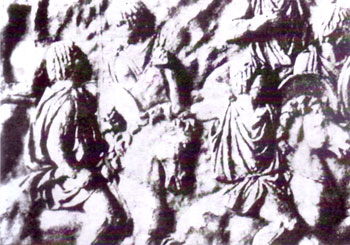
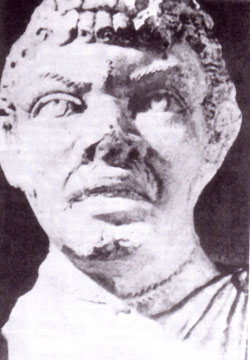
An original brass military diploma which dates from the middle of the second century A.D. mentions Moorish soldiers in Moesia, which is modern Serbia. Another military diploma of A.D. speaks of Moorish soldiers from Africa in Dacia, or modern Romania, and also of auxiliary troops of the Dacian Moors. A Roman document, Notitia Dignitatum dates from the beginning of the fifth century A.D., mentions several Moorish battalions in the Balkans and the Moorish military colony Ad Mauros was located on the Inn River near Vienna; and in what modern Besarabia, there is was a city called Maurocastrum.

Revis has always considered himself a true Yorkshireman who was proud of his ancestry. But he has been forced to confront an entirely different heritage - after scientists uncovered that he has exactly the same DNA imprint as a tribe of African warriors.
www.dailymail.co.uk...
edit on 17-2-2013 by Spider879 because: (no reason given)
edit on 17-2-2013 by Spider879 because: (no reason given)
reply to post by Spider879
The contribution made by people of colour to Western civilisation is certainly an interesting subject. With regard to this thread, however, two comments need to be made.
The above being noted, I would like to dissociate myself from the position of credenceskynyrd, who seems to be offended by any acknowledgement of black people's contribution to Western civilisation and prosperity.
The contribution made by people of colour to Western civilisation is certainly an interesting subject. With regard to this thread, however, two comments need to be made.
- Strictly speaking, a Moor is a more or less dark-skinned Muslim. His origin does not have to be African, and he does not need to be
especially 'black'. In fact, there is a related (and somewhat offensive) term, blackamoor,
which serves to distinguish a dark-skinned Moor.
Wikipedia
Dictionary
- You missed out a few reasons why a Moor might appear on a European coat of arms.
(i) the person to whom the arms were originally awarded may have made his wealth trading in slaves.
The first recorded slaving voyage to west Africa was made in 1562 by Devon born Captain John Hawkins who captured 300 people from what is now Sierra Leone, to be sold as slaves in the Caribbean. The profit he made from that voyage allowed him to get backing and approval for further slave trading ventures from Queen Elizabeth I. In fact, Hawkins was knighted shortly after his second successful African venture and his coat of arms below depicted the head of an African woman with a chain around her neck. Source
(ii) He may have fought successfully against Moorish pirates.
Seelig points out a contradiction between the role of Roberto Pucci as commander of the order of Santo Stefano, responsible for chasing African pirates, and the attractive representation of the African head in his coat of arms. This is exactly the origin of the fashionable heraldry of African heads in many medieval coats of arms in Europe, following the crusades and the naval conflicts in Mediterranean. Source
(iii) An African on a coat of arms may also celebrate a role in the abolition of slavery.
Part of Kettering's coat of arms features a black man with a broken chain dangling from his wrist. This image symbolises the abolitionist work of a son of the town, the Reverend William Knibb, who campaigned against human bondage in Jamaica. Source
The above being noted, I would like to dissociate myself from the position of credenceskynyrd, who seems to be offended by any acknowledgement of black people's contribution to Western civilisation and prosperity.
edit on 17/2/13 by Astyanax because: of dissociation
Originally posted by Astyanax
reply to post by Spider879
The contribution made by people of colour to Western civilisation is certainly an interesting subject. With regard to this thread, however, two comments need to be made.
- Strictly speaking, a Moor is a more or less dark-skinned Muslim. His origin does not have to be African, and he does not need to be especially 'black'. In fact, there is a related (and somewhat offensive) term, blackamoor, which serves to distinguish a dark-skinned Moor.
Wikipedia
Dictionary
- You missed out a few reasons why a Moor might appear on a European coat of arms.
(i) the person to whom the arms were originally awarded may have made his wealth trading in slaves.
The first recorded slaving voyage to west Africa was made in 1562 by Devon born Captain John Hawkins who captured 300 people from what is now Sierra Leone, to be sold as slaves in the Caribbean. The profit he made from that voyage allowed him to get backing and approval for further slave trading ventures from Queen Elizabeth I. In fact, Hawkins was knighted shortly after his second successful African venture and his coat of arms below depicted the head of an African woman with a chain around her neck. Source
(ii) He may have fought successfully against Moorish pirates.
Seelig points out a contradiction between the role of Roberto Pucci as commander of the order of Santo Stefano, responsible for chasing African pirates, and the attractive representation of the African head in his coat of arms. This is exactly the origin of the fashionable heraldry of African heads in many medieval coats of arms in Europe, following the crusades and the naval conflicts in Mediterranean. Source
(iii) An African on a coat of arms may also celebrate a role in the abolition of slavery.
Part of Kettering's coat of arms features a black man with a broken chain dangling from his wrist. This image symbolises the abolitionist work of a son of the town, the Reverend William Knibb, who campaigned against human bondage in Jamaica. Source
The above being noted, I would like to dissociate myself from the position of credenceskynyrd, who seems to be offended by any acknowledgement of black people's contribution to Western civilisation and prosperity.
edit on 17/2/13 by Astyanax because: of dissociation
Actually I made it a pont to say in my opening post that all Moors on coat of arms are not founders of that family that some were on there due to fighting Moors rather than having babies with them,but one have to consider the name Moor,Moorison,Black,Blackman,Blackson etc, just like you would Jew,Jewison,or from an occuption like Baker,Farmer,Archer and the like in conjuntion with the images on the coat of arms if one have the time please check out Fairbirns Book of Crest
www.scribd.com...
edit on 17-2-2013 by Spider879 because: (no reason given)
new topics
-
Farmers wife
Music: 1 hours ago -
NJ Drones tied to Tesla explosion at Trump Las vegas
General Conspiracies: 2 hours ago -
New Jersey-Teachers Can Now Be Certified Without Passing Basic Reading Writing Math Testing
Education and Media: 5 hours ago -
Matthew Livelsberger said he was being followed by FBI
Political Conspiracies: 8 hours ago -
How the Sikhs Deal with Muslim Grooming Gangs – Tommy Robinson
Social Issues and Civil Unrest: 10 hours ago -
Paranoid Liberals Believe U.S. Service Members are More Dangerous than Illegal Aliens.
Social Issues and Civil Unrest: 11 hours ago
top topics
-
Matthew Livelsberger said he was being followed by FBI
Political Conspiracies: 8 hours ago, 16 flags -
FIEND SLASHED: Sara Sharif’s killer dad ‘has neck & face sliced open with jagged tuna tin lid
Mainstream News: 17 hours ago, 11 flags -
Here we again... CHINA having mass outbreak of something
Diseases and Pandemics: 12 hours ago, 8 flags -
The 119th Congress has Officially Opened for Business
Mainstream News: 12 hours ago, 7 flags -
New Jersey-Teachers Can Now Be Certified Without Passing Basic Reading Writing Math Testing
Education and Media: 5 hours ago, 6 flags -
How the Sikhs Deal with Muslim Grooming Gangs – Tommy Robinson
Social Issues and Civil Unrest: 10 hours ago, 6 flags -
Paranoid Liberals Believe U.S. Service Members are More Dangerous than Illegal Aliens.
Social Issues and Civil Unrest: 11 hours ago, 6 flags -
Flee from idolatry
Religion, Faith, And Theology: 17 hours ago, 3 flags -
NJ Drones tied to Tesla explosion at Trump Las vegas
General Conspiracies: 2 hours ago, 3 flags -
Farmers wife
Music: 1 hours ago, 0 flags
active topics
-
Watts home paranormal activity
Paranormal Studies • 6 • : TowmasterLG -
Congress Says the FBI is Covering Up Vital Info on the Jan 5th 2021 D.C. Pipe Bombs at RNC-DNC.
Political Conspiracies • 28 • : GotterDameron23 -
Matthew Livelsberger said he was being followed by FBI
Political Conspiracies • 60 • : rickymouse -
Tesla Cybertruck Explodes in Front of Trump Hotel in Las Vegas
Mainstream News • 194 • : Mantiss2021 -
-@TH3WH17ERABB17- -Q- ---TIME TO SHOW THE WORLD--- -Part- --44--
Dissecting Disinformation • 3922 • : 777Vader -
New Jersey-Teachers Can Now Be Certified Without Passing Basic Reading Writing Math Testing
Education and Media • 9 • : rickymouse -
NJ Drones tied to Tesla explosion at Trump Las vegas
General Conspiracies • 6 • : berbofthegreen -
Candidate TRUMP Now Has Crazy Judge JUAN MERCHAN After Him - The Stormy Daniels Hush-Money Case.
Political Conspiracies • 2171 • : WeMustCare -
US disburses $3.4 billion in budget aid for Ukraine, Yellen says
US Political Madness • 30 • : WeMustCare -
Paranoid Liberals Believe U.S. Service Members are More Dangerous than Illegal Aliens.
Social Issues and Civil Unrest • 28 • : WeMustCare
